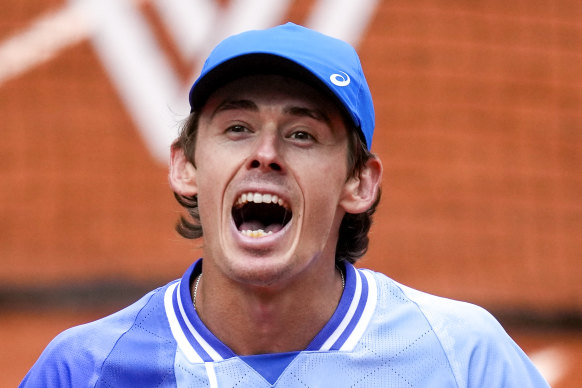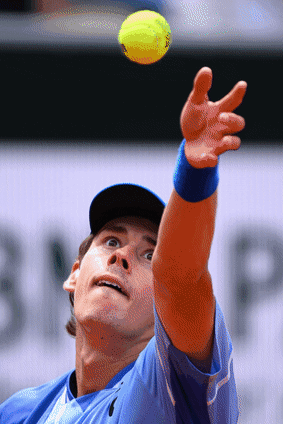- Analysis
- Sport
- Tennis
- French Open
‘Being a defender wasn’t going to cut it’: The numbers behind the Demon’s world-class weaponry
By Marc McGowan
Alex de Minaur’s transformation from admired also-ran into world-beating top-10 star has captured Australia’s attention.
The Demon’s career-defining upset of world No.5 and 2021 US Open champion Daniil Medvedev to reach his maiden Roland-Garros quarter-final cemented his new status as a tour force, only 19 months removed from never having beaten a top-five rival.

Alex De Minaur celebrates winning his fourth round match of the French Open tennis tournament against Russia’s Daniil Medvedev.Credit: AP
De Minaur ended an 18-match drought against such opponents at Medvedev’s expense at the Paris Masters in November 2022, kick-starting an extraordinary period for the Australian No.1.
He boasts 11 top-10 victories since the start of last year, including six more over top-five stars, and achieved his career-high ranking of No.9 in mid-February after reaching the ATP 500 final in Rotterdam, where it took Australian Open champion Jannik Sinner to stop him.
So, how has de Minaur done it?
As always, there is some educated guesswork and intangibles involved, such as confidence and mentality, but analysis of the numbers helps explain the upgraded de Minaur, or at least show where he is making inroads on his elite peers.
The 25-year-old offered an insight in January into how he had to change the way he approached the game to climb the ATP Tour’s pecking order.
“I knew in the past that maybe being a defender or counter-puncher wasn’t going to beat the top guys in the world,” de Minaur said.
“I had to improve in that aspect and develop a more aggressive playing style.”
The serve
De Minaur’s serve has often been regarded as a weakness, but it was a genuine weapon in his defeat of Medvedev at Roland-Garros.
His first serve topped out at 216km/h – 10km/h faster than Medvedev’s best effort, despite de Minaur being 15 centimetres shorter – and he was also superior in average first- and second-serve speed by 9km/h and 12km/h, respectively.
If we rewind to de Minaur’s first-round match at Roland-Garros two years ago, his fastest serve then was 195km/h, and he averaged only 181km/h on his first serve, as opposed to 198km/h against Medvedev.
“I watched his matches on clay this year to try to see which tactic to play,” Medvedev said. “I didn’t see him play like this. He was missing more. He was serving better than most guys I played on clay, so that was surprising.”
ATP Tour data reveals de Minaur’s first-serve winning percentage has spiked from 69 per cent in 2021-22 to 72 per cent the past two years, but it is on the second serve that he has become one of the best on tour.
He ranks sixth in the past 12 months for second-serve winning percentage – behind only Novak Djokovic, Carlos Alcaraz, Jannik Sinner, countryman Jordan Thompson and Taylor Fritz – up from 17th last year.
“That ability to deflect, or withstand, that pressure on second serve is huge,” Tennis Australia’s senior manager of game analysis, Nick Kyrgios’ ex-coach Simon Rea, told this masthead.
“It’s only a two per cent improvement from 2023 to what he’s done over the last 12 months [53.5 per cent to 55.2], so is that technical, tactical or mental?
“We could all hypothesise, but being able to shift the needle from 17th to sixth is enough to put you in these positions, like the last eight at Roland-Garros, which is a fantastic result, given he didn’t even want to know about claycourts in the past.”
Australian tennis great Todd Woodbridge, who commentated de Minaur’s win for Channel Nine, has noticed subtle changes in the world No.11’s service motion.
Woodbridge also believes de Minaur’s bigger and stronger legs are another major factor in his supercharged serve, which has delivered him far more aces and “cheap” points this year.
“Previously, if you looked at the start of his action ... he kept his shoulders very straight, and parallel to the centre line of the court,” Woodbridge said.
“The best servers in the world rotate their shoulders and almost have their back to the court – and he is slowly trying to change that, to get his right shoulder to pull back further to get that rotation, which gives him a, more power, and b, more shape on his second serve.
“I still think he’s only halfway there, and in another year or two, we will hopefully see it rotate even more so.”
The return game
De Minaur has not just focused on strengthening his weaknesses.
Tennis Australia’s data from the past two Australian summers showed that de Minaur’s extra aggression went beyond hitting harder serves and ground-strokes, and taking more risks in general.
De Minaur’s return position was also more aggressive, mirroring his want in rallies to take the ball earlier to rush his opponents and make up for any power deficit to them.
In the 2023 Australian summer, he returned 30 per cent of second serves inside the baseline and a further 12 per cent within two metres of the baseline. De Minaur’s impact point on the remaining 58 per cent were more than two metres behind the baseline.
Fast-forward to this past January, and the difference was stark.
He hit 39.3 per cent of second-serve returns inside the baseline, 20.2 per cent within two metres of the baseline and only 40.5 per cent deeper than two metres.
“That’s a significant shift – circa 20 per cent increase, in terms of balls impacted within two metres of the baseline – towards occupying a more aggressive or threatening second-serve return position, based on what we observed,” Rea said.
De Minaur rates as the No.2 returner in the past year on an ATP Tour formula that factors in percentage of first- and second-serve return points won, return games won and break points converted.
His improvement on clay

Alex de Minaur’s improved serve in action in his win over Daniil Medvedev.Credit: Getty Images
The other key question is how de Minaur transformed from a “clay duffer” to now jokingly referring to himself as a claycourt specialist.
He had never advanced beyond the second round at Roland-Garros before this stunning quarter-final run.
There is no single answer to this, but Woodbridge, who was bullish on de Minaur’s chances pre-tournament, theorises that the new-found success on the red dirt owes largely to his vastly improved physicality.
“That extra little bit of muscle and weight has allowed him to absorb being hit at more,” Woodbridge said.
“On the clay, those who have a really big forehand, like Alcaraz or Rafa [Nadal], have an advantage because it jumps up and out, and Alex would get hurt out in the corners and find it harder to get back in a neutral position.
“But he’s better now at being able to absorb that ball, and not get pushed around the court as much as he was, so he doesn’t feel as much pressure to go for such a big shot in the first five to 10 shots.”
News, results and expert analysis from the weekend of sport sent every Monday. Sign up for our Sport newsletter.